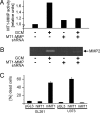Gliomas induce and exploit microglial MT1-MMP expression for tumor expansion
- PMID: 19617536
- PMCID: PMC2718387
- DOI: 10.1073/pnas.0804273106
Gliomas induce and exploit microglial MT1-MMP expression for tumor expansion
Abstract
Diffuse infiltration of glioma cells into normal brain tissue is considered to be a main reason for the unfavorable outcomes of patients with malignant gliomas. Invasion of glioma cells into the brain parenchyma is facilitated by metalloprotease-mediated degradation of the extracellular matrix. Metalloproteases are released as inactive pro-forms and get activated upon cleavage by membrane bound metalloproteases. Here, we show that membrane type 1 metalloprotease (MT1-MMP) is up-regulated in glioma-associated microglia, but not in the glioma cells. Overexpression of MT1-MMP is even lethal for glioma cells. Glioma-released factors trigger the expression and activity of MT1-MMP via microglial toll-like receptors and the p38 MAPK pathway, as deletion of the toll-like receptor adapter protein MyD88 or p38 inhibition prevented MT1-MMP expression and activity in cultured microglial cells. Microglial MT1-MMP in turn activates glioma-derived pro-MMP-2 and promotes glioma expansion, as shown in an ex vivo model using MT1-MMP-deficient brain tissue and a microglia depletion paradigm. Finally, MyD88 deficiency or microglia depletion largely attenuated glioma expansion in 2 independent in vivo models.
Conflict of interest statement
The authors declare no conflict of interest.
Figures





Similar articles
-
Glioma-derived versican promotes tumor expansion via glioma-associated microglial/macrophages Toll-like receptor 2 signaling.Neuro Oncol. 2015 Feb;17(2):200-10. doi: 10.1093/neuonc/nou324. Epub 2014 Dec 1. Neuro Oncol. 2015. PMID: 25452390 Free PMC article.
-
Toll-like receptor 2 mediates microglia/brain macrophage MT1-MMP expression and glioma expansion.Neuro Oncol. 2013 Nov;15(11):1457-68. doi: 10.1093/neuonc/not115. Epub 2013 Sep 5. Neuro Oncol. 2013. PMID: 24014382 Free PMC article.
-
Glioma-associated microglial MMP9 expression is upregulated by TLR2 signaling and sensitive to minocycline.Int J Cancer. 2014 Dec 1;135(11):2569-78. doi: 10.1002/ijc.28908. Epub 2014 May 9. Int J Cancer. 2014. PMID: 24752463 Free PMC article.
-
Membrane-type matrix metalloproteinases (MT-MMPs): expression and function during glioma invasion.J Neurooncol. 2001 Jun;53(2):187-202. doi: 10.1023/a:1012213604731. J Neurooncol. 2001. PMID: 11716070 Review.
-
Potential target within the tumor microenvironment - MT1-MMP.Front Immunol. 2025 Mar 24;16:1517519. doi: 10.3389/fimmu.2025.1517519. eCollection 2025. Front Immunol. 2025. PMID: 40196128 Free PMC article. Review.
Cited by
-
Glioma Stem Cells but Not Bulk Glioma Cells Upregulate IL-6 Secretion in Microglia/Brain Macrophages via Toll-like Receptor 4 Signaling.J Neuropathol Exp Neurol. 2016 May;75(5):429-40. doi: 10.1093/jnen/nlw016. Epub 2016 Mar 30. J Neuropathol Exp Neurol. 2016. PMID: 27030742 Free PMC article.
-
Inhibition of purinergic P2X receptor 7 (P2X7R) decreases granulocyte-macrophage colony-stimulating factor (GM-CSF) expression in U251 glioblastoma cells.Sci Rep. 2020 Sep 9;10(1):14844. doi: 10.1038/s41598-020-71887-x. Sci Rep. 2020. PMID: 32908225 Free PMC article.
-
Reduced microglial CX3CR1 expression delays neurofibromatosis-1 glioma formation.Ann Neurol. 2013 Feb;73(2):303-8. doi: 10.1002/ana.23813. Epub 2013 Feb 19. Ann Neurol. 2013. PMID: 23424002 Free PMC article.
-
Synergistic Toll-like Receptor 3/9 Signaling Affects Properties and Impairs Glioma-Promoting Activity of Microglia.J Neurosci. 2020 Aug 12;40(33):6428-6443. doi: 10.1523/JNEUROSCI.0666-20.2020. Epub 2020 Jul 6. J Neurosci. 2020. PMID: 32631940 Free PMC article.
-
The Role of Cytokines and Chemokines in Shaping the Immune Microenvironment of Glioblastoma: Implications for Immunotherapy.Cells. 2021 Mar 9;10(3):607. doi: 10.3390/cells10030607. Cells. 2021. PMID: 33803414 Free PMC article. Review.
References
-
- Osenkowski P, Toth M, Fridman R. Processing, shedding, and endocytosis of membrane type 1-matrix metalloproteinase (MT1-MMP) J Cell Physiol. 2004;200:2–10. - PubMed
-
- Mayes DA, et al. PAX6 suppresses the invasiveness of glioblastoma cells and the expression of the matrix metalloproteinase-2 gene. Cancer Res. 2006;66:9809–9817. - PubMed
-
- Rao JS. Molecular mechanisms of glioma invasiveness: the role of proteases. Nat Rev Cancer. 2003;3:489–501. - PubMed
-
- Olson JK, Miller SD. Microglia initiate central nervous system innate and adaptive immune responses through multiple TLRs. J Immunol. 2004;173:3916–3924. - PubMed
Publication types
MeSH terms
Substances
Grants and funding
LinkOut - more resources
Full Text Sources
Other Literature Sources
Molecular Biology Databases

